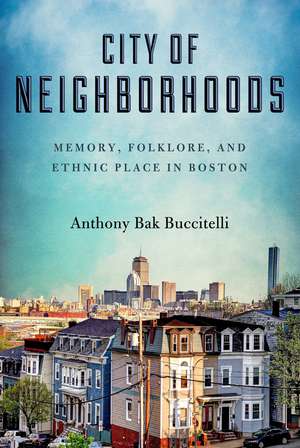City of Neighborhoods: Memory, Folklore, and Ethnic Place in Boston: Folklore Studies in a Multicultural World
Autor Anthony Bak Buccitellien Limba Engleză Hardback – 19 apr 2016
East Boston has long been known as an Italian neighborhood and Southie as an Irish one, while nearby North Quincy has seen in recent decades an influx of Chinese Americans and immigrants. Such urban spaces in America can become intimately intertwined with ethnic identities (Little Italy, Greektown, Chinatown, Little Havana). Yet local residents often readily acknowledge an underlying diversity—both historically and as a result of more recent changes—that complicates such stereotypes.
Digging into the ever-shifting terrain of American ethnicity and urban spaces, Anthony Bak Buccitelli investigates folk practices, social memory, and local histories in three Boston-area neighborhoods. He looks at the ways locals represent their neighborhoods and themselves via events, symbols, stories, and landmarks, from the shamrock to the Chinese flag, whether the St. Patrick’s Day parade in Southie or the Columbus Day parade in East Boston, from urban graffiti and websites to the Dorchester Heights Monument. City of Neighborhoods exposes the processes of selection and emphasis that produce, sustain, challenge, and change understandings of urban spaces as ethnic places.
Honorable mention, Wayland Hand Prize for Folklore and History, American Folklore Society
Digging into the ever-shifting terrain of American ethnicity and urban spaces, Anthony Bak Buccitelli investigates folk practices, social memory, and local histories in three Boston-area neighborhoods. He looks at the ways locals represent their neighborhoods and themselves via events, symbols, stories, and landmarks, from the shamrock to the Chinese flag, whether the St. Patrick’s Day parade in Southie or the Columbus Day parade in East Boston, from urban graffiti and websites to the Dorchester Heights Monument. City of Neighborhoods exposes the processes of selection and emphasis that produce, sustain, challenge, and change understandings of urban spaces as ethnic places.
Honorable mention, Wayland Hand Prize for Folklore and History, American Folklore Society
Preț: 475.94 lei
Preț vechi: 559.93 lei
-15% Nou
Puncte Express: 714
Preț estimativ în valută:
91.08€ • 95.77$ • 75.25£
91.08€ • 95.77$ • 75.25£
Carte tipărită la comandă
Livrare economică 17 aprilie-01 mai
Preluare comenzi: 021 569.72.76
Specificații
ISBN-13: 9780299307103
ISBN-10: 0299307107
Pagini: 240
Ilustrații: 3 b-w illus., 3 maps
Dimensiuni: 152 x 229 x 20 mm
Greutate: 0.34 kg
Ediția:1
Editura: University of Wisconsin Press
Colecția University of Wisconsin Press
Seria Folklore Studies in a Multicultural World
ISBN-10: 0299307107
Pagini: 240
Ilustrații: 3 b-w illus., 3 maps
Dimensiuni: 152 x 229 x 20 mm
Greutate: 0.34 kg
Ediția:1
Editura: University of Wisconsin Press
Colecția University of Wisconsin Press
Seria Folklore Studies in a Multicultural World
Recenzii
“This fascinating deep-dive into historically ethnic neighborhoods reveals that old stereotypes have been supplanted by vibrant, multiethnic neighborhoods that now use ethnicity as a means for inclusion. A riveting, insider look into what really happens in Boston’s diverse neighborhoods.”—Timothy Tangherlini, University of California, Los Angeles
“Deftly explores key ways in which who we are is inseparable from where we are. The neighborhoods Buccitelli examines are not simply parts of a city; they are complex systems of memories, symbols, stories, celebrations, tribal landmarks, claims and counterclaims, all coming together to express distinct ethnic identities in everyday life.”—Kent C. Ryden, author of Mapping the Invisible Landscape: Folklore, Writing, and the Sense of Place
“Pushes beyond ethnic stereotypes toward a more nuanced understanding of ethnicity in the region and its manifestations in memory, symbols, celebrations, narrative, and social media communication and connection.”—Choice
Notă biografică
Anthony Bak Buccitelli is an assistant professor of American studies and communications at Pennsylvania State University, Harrisburg. He grew up in Hingham, Massachusetts.
Cuprins
List of Illustrations
Acknowledgments
Introduction: City of Neighborhoods 3
1 Spaces of Memory: Local History Writing, Folk Geography, and Discourses of Ethnic Place in South Boston and North Quincy
2 The Wearing of the Green and the Coming of the Reds: Ethnic Symbols, Intertextuality, and Indexed Memory
3 “I Always Felt Like East Boston Was an Italian Community, and We Just Lived Here”: Ethnicity and Personalization in Local Memory Traditions
4 Festive Locales: Ethnic Celebrations and Local Meanings
5 Virtually a Local: Folk Geography, Digital Technology, and Social Memory
Conclusion: Memory, Folklore, and Ethnic Place in Boston
Notes
Bibliography
Index
Acknowledgments
Introduction: City of Neighborhoods 3
1 Spaces of Memory: Local History Writing, Folk Geography, and Discourses of Ethnic Place in South Boston and North Quincy
2 The Wearing of the Green and the Coming of the Reds: Ethnic Symbols, Intertextuality, and Indexed Memory
3 “I Always Felt Like East Boston Was an Italian Community, and We Just Lived Here”: Ethnicity and Personalization in Local Memory Traditions
4 Festive Locales: Ethnic Celebrations and Local Meanings
5 Virtually a Local: Folk Geography, Digital Technology, and Social Memory
Conclusion: Memory, Folklore, and Ethnic Place in Boston
Notes
Bibliography
Index
Descriere
Reveals that stereotypical ethnic neighborhoods have developed into multicultural communities that use ethnic symbolism as a means for inclusion, not exclusion.

















